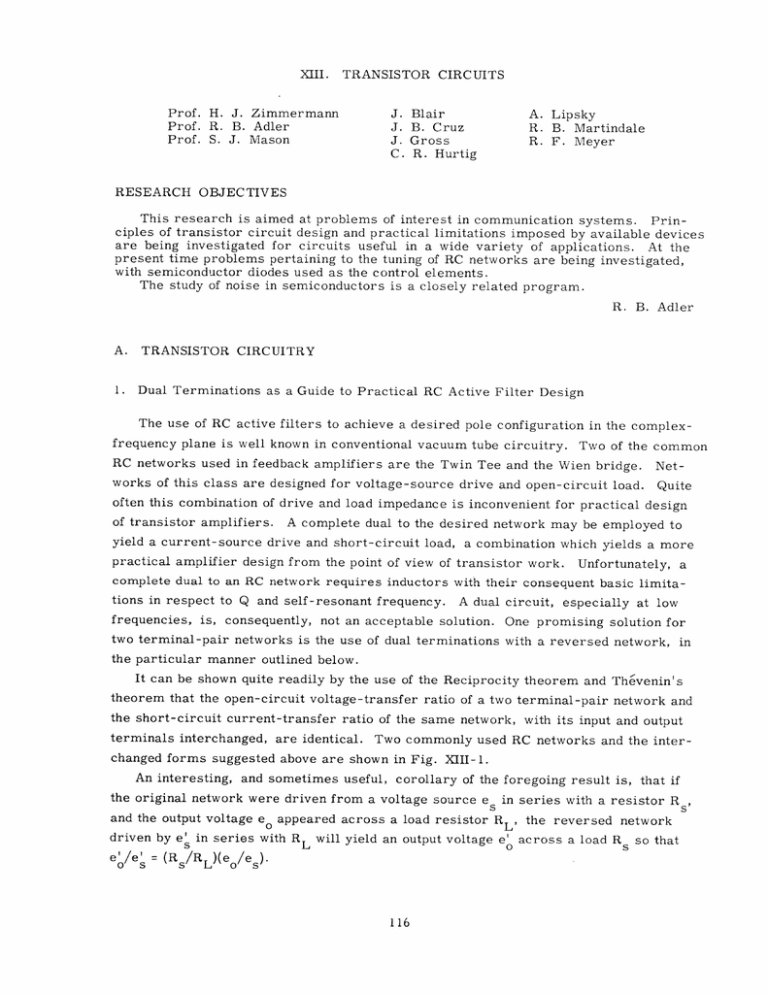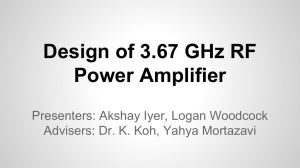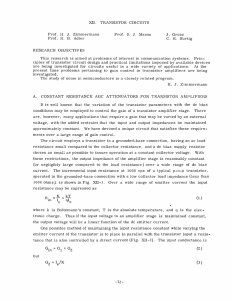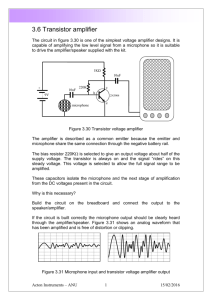XIII. TRANSISTOR CIRCUITS Prof. H. J. Zimmermann
advertisement

XIII. TRANSISTOR Prof. H. J. Zimmermann Prof. R. B. Adler Prof. S. J. Mason J. J. J. C. CIRCUITS Blair B. Cruz Gross R. Hurtig A. Lipsky R. B. Martindale R. F. Meyer RESEARCH OBJECTIVES This research is aimed at problems of interest in communication systems. Principles of transistor circuit design and practical limitations imposed by available devices are being investigated for circuits useful in a wide variety of applications. At the present time problems pertaining to the tuning of RC networks are being investigated, with semiconductor diodes used as the control elements. The study of noise in semiconductors is a closely related program. R. A. i. B. Adler TRANSISTOR CIRCUITRY Dual Terminations as a Guide to Practical RC Active Filter Design The use of RC active filters to achieve a desired pole configuration in the complex- frequency plane is well known in conventional vacuum tube circuitry. Two of the common RC networks used in feedback amplifiers are the Twin Tee and the Wien bridge. Networks of this class are designed for voltage-source drive and open-circuit load. Quite often this combination of drive and load impedance is inconvenient for practical design of transistor amplifiers. A complete dual to the desired network may be employed to yield a current-source drive and short-circuit load, a combination which yields a more practical amplifier design from the point of view of transistor work. Unfortunately, a complete dual to an RC network requires inductors with their consequent basic limitations in respect to Q and self-resonant frequency. A dual circuit, especially at low frequencies, is, consequently, not an acceptable solution. One promising solution for two terminal-pair networks is the use of dual terminations with a reversed network, in the particular manner outlined below. It can be shown quite readily by the use of the Reciprocity theorem and Thevenin's theorem that the open-circuit voltage-transfer ratio of a two terminal-pair network and the short-circuit current-transfer ratio of the same network, with its input and output terminals interchanged, are identical. Two commonly used RC networks and the inter- changed forms suggested above are shown in Fig. XIII-1. An interesting, and sometimes useful, corollary of the foregoing result is, that if the original network were driven from a voltage source es in series with a resistor Rs' and the output voltage e appeared across a load resistor R L , the reversed network driven by e' in series with RL will yield an output voltage e' e'/e' = (Rs/RL)(e /e). 0os s L 0os 116 across a load R so that REVERSED NETWORK NETWORK R, TWIN TEE e R, C e o is C (WIEN-BRIDGE DERIVED) R R, C2 ei R2 e C, 2 2 e Fig. XIII-1. SF(jw) H Two basic networks and their corresponding reversed forms with dual terminations. INPUT e s 1004f Fig. XIII-2. Twin Tee amplifier with voltage-tuned center frequency. 117 ^^^^ UUU200C o 1500 r. w 1000 W 0 a: LL 500 - k2 0 Fig. XIII-3. II 2 II 4 1I 6 II 8 I 10 15 20 25 CONTROL VOLTAGE (VOLTS) i II 30 35 Center frequency versus control-voltage characteristic of the Twin Tee amplifier. - 1- - 05 20 CONTROL VOLTAGE Fig. XIII-4. (VOLTS) Q versus control voltage for Twin Tee amplifier. 118 (XIII. 2. TRANSISTOR CIRCUITS) Voltage-Tuned RC Active Filters In an RC active filter the pole locations are moved from the negative real axis to some other location in the complex plane by the use of feedback. In ordinary circuit design, the magnitude of the vector from the origin to the pole is inversely proportional to an RC product, but the angle of the vector with respect to the coordinate system is independent of the RC product. By the use of forward-biased junction diodes as the resistive components of the RC filter, the magnitude of the vector from the origin to the pole may be made a linear function of a control signal over a large range (ten to one) of control signals. This circumstance follows because the dynamic resistance of the diodes is inversely proportional to the direct current flowing through them. The design of voltage-controlled variable-frequency RC active filters is predicated on the use of the incremental resistance of junction diodes. The range over which this incremental resistance is inversely proportional to the direct-current bias extends from a few hundred microamperes to fractions of a microampere. The nominal range of control signals used in circuits thus far is from 20 famp to 200 4amp. There are two basic limitations to extending the lower value of the range of control current. Both limitations arise because the ac signal must be small compared to the direct-control current. Transistor noise and the required dynamic range place one limitation on the ac signal current. Allowable distortion, which is also a function of the configuration of the RC filter, may place a conflicting requirement on the value of the ac signal current. In the circuits designed up to the present time a dynamic range of 40 db with distortion less than 5 per cent seems consistent with the range of control signals quoted above. The circuit diagram of a voltage-controlled Twin Tee amplifier that makes use of the concept of dual terminations (see Section XIII-1), is shown in Fig. XIII-2. The control current for the junction diodes is obtained from a variable voltage source in series with fixed resistors of large value. The first transistor is employed to furnish a current-gain amplifier, the second to provide an approximation to a current-source drive for the Twin Tee network, and the third to approximate a short-circuit loading for the Twin Tee. in Fig. XIII-3. A curve relating the center frequency to the control voltage is shown The linearity of this characteristic was within the measurement accuracy of the voltmeter (±2 per cent). The Q of the Twin Tee amplifier was nominally 7. 8, and its variation with control signal is shown in Fig. XIII-4. A frequency-modulated, low-frequency oscillator employing an RC network derived from the Wien bridge has been built and is now being tested. The frequency range is from 160 cps to 1600 cps, with a linearity, as a function of control voltage, of the same order of magnitude as that shown in Fig. XIII-3. C. 119 R. Hurtig








